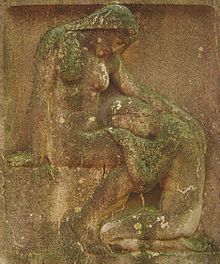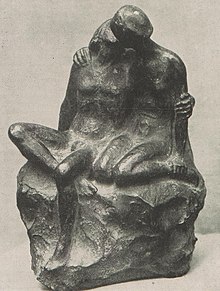Rudolf Bosselt
Rudolf Bosselt (born June 29, 1871 in Perleberg ; † January 2, 1938 in Berlin ; full name: Paul Gustav Rudolf Bosselt ) was a German sculptor , medalist and reformist teacher.
Life

After an apprenticeship as a chaser in a bronze foundry in Berlin, he worked for the Royal Porcelain Manufactory in Charlottenburg . From 1891 to 1897 he was a student of Joseph Kowarzik at the Städel Institute in Frankfurt am Main. Then he went to Paris to the Académie Julian . From 1899 he worked as a founding member in the Darmstadt artists' colony . On the recommendation of Peter Behrens , he taught at the Düsseldorf School of Applied Arts from 1904 . For the world exhibition in Brussels in 1910 , he designed a highly acclaimed exhibition of his medals and plaques. In 1911 he took over as director of the Magdeburg School of Applied Arts and Crafts , whose teaching program he redesigned in line with the German Werkbund . After Bruno Taut criticized this teaching program, Bosselt left Magdeburg and took over the management of the arts and crafts school in Braunschweig from 1928 to 1931 . In September 1931 he returned to Berlin to succeed Otto Marcus as General Secretary of the Reich Association of German Artists . After being replaced from this position, he was in charge of the journal Art and Science . In 1932 he represented Germany at the Olympic Games with the "Constitutional Plaque 1931" at the art competitions.
Bosselt is one of the leading representatives of Art Nouveau in Germany and is considered to be the innovator of German medal art . He created numerous small sculptures (portrait and exhibition medals and plaques), grave and fountain figures, animal sculptures and portrait busts. His grave is in the south-west cemetery Stahnsdorf .
Works
- Love and loyalty, engagement plaque (1898)
- Sculpture on the facade of the Kleine Glückert House (Bosselt House) on Mathildenhöhe in Darmstadt (1900)
- Johannes Gutenberg Medal on the occasion of his 500th birthday (1900)
- Victory geniuses at the Ernst Ludwig House on Mathildenhöhe in Darmstadt (1901)
- Hamburg Rescue Medal (1903)
- The marble bench with cats was made for the "Architectural Garden" by Peter Behrens at the Kunstpalast . The bench, one of two benches, was a foundation by Georg Oeder and was set up on the Goltsteinparterre behind the Düsseldorf theater after the Great Horticultural Exhibition . (1904)
- Tomb of the Clouth family in the Melaten cemetery in Cologne (1904)
- Youth, Plastic (1904)
- Competition draft for a Bismarck national monument on the Elisenhöhe near Bingerbrück (1910; not awarded)
- Commemorative medal at the world exhibition in Brussels (1910)
- Relief on the grave of Richard Zuntz in Bonn-Poppelsdorf (around 1910)
- Draft of the emergency money of the province of Westphalia with the head of Baron vom Stein (1921–1923)
- Commemorative coin (3 Reichsmark) for the 10th anniversary of the Weimar Constitution (1929)
- Honorary Prize of the Reich President, Medal for the Constitutional Day (1931)
- Honorary Prize of the Reich President, Constitution Day Medal (1932)
- Wooden Roland in front of Magdeburg City Hall (1933)
Fonts
- About the art of the medal. Darmstadt 1905.
- The training of artistic and technical forces for the arts and crafts. Düsseldorf 1908.
- Knowing the art. Hanover 1913.
- War and German fashion. Munich 1915.
- Problems of plastic art and art teaching. Magdeburg 1919.
- A contribution to the characteristics of Expressionism. Munich 1920.
- Applied arts. A report on the development and activity of the craft and applied arts schools in Prussia. Berlin 1922. (with Hans Busch and Hermann Muthesius).
literature
- Bosselt, Rudolf . In: Ulrich Thieme , Felix Becker (Hrsg.): General Lexicon of Fine Artists from Antiquity to the Present . Founded by Ulrich Thieme and Felix Becker. tape 4 : Bida – Brevoort . Wilhelm Engelmann, Leipzig 1910, p. 404 ( Textarchiv - Internet Archive ).
- Bosselt, Rudolf . In: General Artist Lexicon . The visual artists of all times and peoples (AKL). Volume 13, Saur, Munich a. a. 1996, ISBN 3-598-22753-1 , pp. 208 f.
- German Biographical Encyclopedia . 2nd edition, Volume 1. Munich 2005, p. 856.
- Vera Losse: Rudolf Bosselt. Innovator of German medal art, sculptor and reform pedagogue. Cologne 1995.
- Uwe-Jens Gellner: Bosselt, Paul Gustav Rudolf. In: Guido Heinrich, Gunter Schandera (ed.): Magdeburg Biographical Lexicon 19th and 20th centuries. Biographical lexicon for the state capital Magdeburg and the districts of Bördekreis, Jerichower Land, Ohrekreis and Schönebeck. Scriptum, Magdeburg 2002, ISBN 3-933046-49-1 , p. 83 f.
- Dieter Lorenz: Traces of Artists in Berlin from the Baroque to Today. Berlin 2002, p. 71 u. 241.
- Olaf Gisbertz: Bruno Taut and Johannes Göderitz in Magdeburg. Architecture and urban development in the Weimar Republic. Berlin 2000, pp. 64-70.
Web links
- Rudolf Bosselt in the Magdeburg Biographical Lexicon
- Medals from Rudolf Bosselt in the interactive catalog of the Münzkabinett of the Staatliche Museen zu Berlin
Individual evidence
- ↑ Rudolf Bosselt in the Sports-Reference database (English; archived from the original )
- ^ Franklin Kopitzsch , Daniel Tilgner (ed.): Hamburg Lexikon. 4th, updated and expanded special edition. Ellert & Richter, Hamburg 2010, ISBN 978-3-8319-0373-3 , p. 301.
- ^ Günter Leitner: Cemeteries in Cologne. In the middle of life . Jürgen Fritsch Verlag, Neumarkt 2003, ISBN 3-936333-01-7 , p. 84 .
- ↑ Max Schmid (ed.): One hundred designs from the competition for the Bismarck National Monument on the Elisenhöhe near Bingerbrück-Bingen. Düsseldorfer Verlagsanstalt, Düsseldorf 1911. (n. Pag.)
| personal data | |
|---|---|
| SURNAME | Bosselt, Rudolf |
| ALTERNATIVE NAMES | Bosselt, Paul Gustav Rudolf (full name) |
| BRIEF DESCRIPTION | German sculptor, medalist and reform pedagogue |
| DATE OF BIRTH | June 29, 1871 |
| PLACE OF BIRTH | Pearl Mountain |
| DATE OF DEATH | January 2, 1938 |
| Place of death | Berlin |


